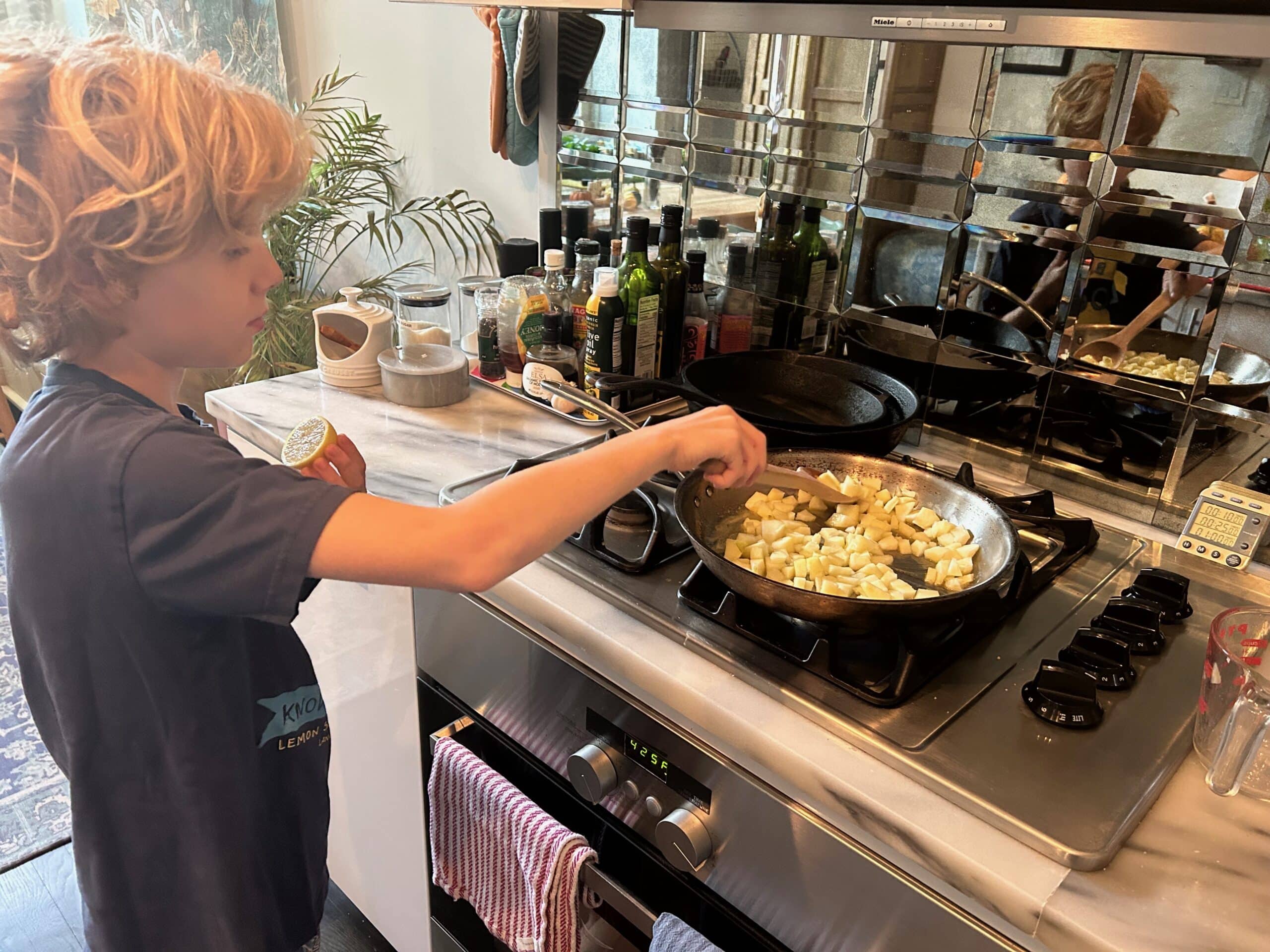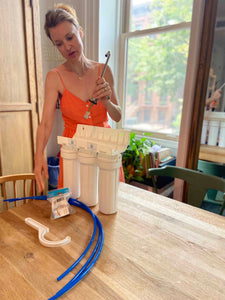Types of Toxic & Non-Toxic Cookware
Pots and pans come in a wide range of materials. Some cookware materials are okay, if you have the right variety, or if you don’t use them every day. Let’s go through these one by one, including the brands we recommend.
Nontoxic Cookware Materials
The following materials are always non-toxic. We will share our favorite brands made of these materials below, under The Best Stuff.
Carbon Steel
Carbon steel is sometimes used for frying pans and woks. It’s similar to cast iron, and can leach small amounts of iron into food, which is great if you have someone with slight anemia in your home!
Cast Iron
For most of human history, people suffered from iron deficiencies, so cooking with cast iron helped to prevent anemia. In modern cultures, the opposite is true. Most of us get plenty of iron, and there’s a point at which ingesting too much can be problematic. In our kitchen, we try to switch between cast iron pans and pans made of other materials throughout the week. If you want to be extra cautious, you could avoid cast iron for recipes with long cooking duration or acidic foods, as this will cause increased iron leaching.
Stainless Steel
Stainless steel pans are generally Good Stuff. The only caveat here is that stainless steel is made with nickel (the more nickel in the mix, the more “stainless” it is). The problem is that our bodies can handle some nickel, but too much isn’t healthy. This means that high quality stainless steel cookware, which has higher percentages of nickel, is actually of more concern than lower quality stainless steel! We know that stainless steel pans do leach nickel (along with some chromium and iron), especially with longer cooking times and when cooking acidic foods such as tomatoes. To minimize the potential for nickel leaching, you’d ideally want a pan that’s 18/4 or 18/0 stainless steel (that first number is the percentage of chromium; the second is nickel). I wouldn’t be concerned about using stainless steel as long as you just switch up your cookware. If you sometimes using cast iron and enamel pots and pans, you won’t be exposing yourself to too much nickel from stainless steel. If you’re still worried, you could avoid stainless steel when cooking acidic foods for long time periods.
Tempered Glass
Glass is probably the most inert of any cooking surface, and you can even get pots and pans made of this ultimate Good Stuff!
Titanium
Titanium is a non-toxic and biocompatible metal, so it is used for medical instruments, dental implant devices, and joint replacements. Titanium is also lightweight and extremely strong. Titanium cookware uses an aluminum base for even heat transfer and distribution. The non-porous, non-stick titanium outer surface does not allow any aluminum to leach through. The only reason to be cautious about titanium cookware is that it seems that most manufacturers now coat their titanium cookware with non-stick finishes, rendering it “Bad Stuff.”
Materials That May Be Safe in Cookware
When shopping for non-toxic cookware, some of these materials come in safe forms. Other times, they are treated (or untreated, as the case may be) in a way that renders them less safe.
Clay
Without testing a clay pot for every possible contaminant, you have no way of knowing what might be leaching into your food. Without a glaze on the pot, there is no protective barrier between what’s in the clay and your meal. The risks of unglazed clay pots and pans outweigh the potential benefits of the good minerals that might leach into your food—calcium, iron, etc.
Coated Ceramic
Made from natural materials such as clay and minerals, ceramic cookware offers excellent heat retention and distribution. Its non-reactive surface makes it ideal for cooking acidic foods, and it is also appreciated for its nontoxic nonstick cookware properties, requiring less oil or fat during cooking. Furthermore, it is generally considered safer than nonstick alternatives since it doesn’t contain potentially harmful chemicals like PFOA or PTFE. Ceramic cookware can be considered a safe less-stick if not truly truly non-stick material. Some ceramic cookware is coated with materials that may contain harmful substances like lead, cadmium, and other heavy metals. To ensure safety, it is crucial to choose ceramic cookware that is labeled as free from toxic materials and is certified as being compliant with safety standards.
Enamel
In essence, enamel is a form of glass. Enameled cookware is most often cast iron with an enamel coating. This type of cookware is wonderful to cook with. Some people have worried about lead in the enamel cookware, since the enamel coating is often made of clay, which can leach lead. For this reason, we suggest choosing high quality enamel cookware from well-known brands.
Materials to Avoid in Cookware
The following materials are always unsafe when used for cookware. You’ll learn more about how to avoid them under the Bad Stuff and Sneaky Stuff, below. Look for cookware brands that they have tested under limits for California Prop 65 for more peace of mind.
- Aluminum
- Copper
- Nonstick/Teflon
- Plastic








































247 comments
Reba
Hi there, I’m just seeing this so forgive me if already mentioned. To expound on The Pampered Chef’s products, above the original article it says non-glazed stoneware is deemed unsafe given it’s unknown what could be leeching into the food. I’ve been using The Pampered Chef bare stones (non glazed) for several years now. Do you suppose though they build up oils for a non-stick coating that they are still considered unsafe to use? (I use bar pan stone, pizza stone and similar as well as muffin pan stone) As with my cast iron pans I only use coconut oil or my own rendered lard from the farm to bake with (unless it’s a meat with it’s own oils.
John Goss
Hi Alyssa,
As for the Ceramacor/Xtrema debate… It is true that lead is ubiquitous in the modern world. It is also true that we should avoid it whenever we can. The tests conducted by Ceramacor are done to discover if any heavy metals could leach from their products over time. This is the extractability test. The test used by Tamara is the XFR test which bombards an object with gamma rays and “reads” the atomic-level reactions for signatures of various compounds/elements. XFR tells us if there are ANY heavy metals in an object. Extractability tells us if any heavy metals are likely to escape from an object and thus present a threat. I believe that Mr Bergstrom is correct when he suggests that there is essentially zero cookware on the planet that is 100% free from any heavy metals or toxins. He is also probably correct that Xtrema cookware is likely the most rigorously tested cookware available. This does not mean that Xtrema is 100% free from lead and the heavy metals. It simply means that exposure to those substances is unlikely. In this particular case they discuss the label baked into the enamel on the bottom of the pan, It seems clear that lead paint may be used on that label. It is also possible that after extensive use/wear the lead in that label might become exposed. That is indeed a concern. The enamel coating applied to these pans is fired at around 2500 degrees…far far hotter than your pan will ever get sitting on top of a burner. This means that it is unlikely to simply melt and expose the offending label. But as we all know, the bottom of pans can become abraded over time and in that way the lead might become exposed. There is no reasonable way for us to determine how many months, years or decades it might take for that to happen. So it comes down to this: Xtrema is likely the most tested cookware on the planet and it appears to pass all the governmental standards. (many governmental standards are not as rigorous as some of us wish but that’s another conversation) Without similar tests conducted on cast iron, stainless steel, carbon steel, glass etc it is not a truly level playing field. People have been cooking with cast iron and stainless steel for a long time so we tend to think they are ok…and generally speaking they probably are ok. Generally speaking Xtrema is likely also ok. If I were in the market for Xtrema I’d probably wait to buy until Mr. Bergstrom changed the labels. Thanks, John GossJohn here from GGS…
Thanks for the great question. I read the blog by Tamara Rubin and followed the back and forth email thread between
Tamara and Richard Bergstrom (Head of Ceramacor/Xtrema) until my eyes were falling out! :)
This is a classic example of just how difficult it can be to arrive at “THE TRUTH” when researching these sorts of things.
Here at Gimme the Good Stuff we try to arrive at conclusions, and make subsequent recommendations based upon reasonable,
real-world concerns. We’ve found that once we skew towards extremes it is a slippery slope into vast amounts of both data
and opinion. Once that starts most of our readers can simply sigh and give up. Our site exists to provide folks with
short-cuts to a realistic view that will allow them quickly make decisions about which products to buy/use while retaining
a sense that they are taking reasonable steps to reduce the toxic load that we are all exposed to.
Alyssa Lindsay
Hi Maia,
I really value your site and use it frequently as a tool for purchasing the healthiest items for my family. I recently went ahead a purchased a few pans from Xtrema and have generally really loved cooking with them, however, I recently came across an article by Tamara Rubin http://tamararubin.com/category/xtrema/ about her finding lead in their branding on the bottom of the cookware. What are you thoughts on this? I really do love the brand and I hope it is safe to cook with. Thank you.Kristin clark
Is the Pioneer Woman porcelain enamel nonstick aluminum cookware safe or sneaky stuff? Thank you!
Bailey
Hello, thank you for the information. Is the Pampered Chef Stoneware line healthy? It seems like a good option that becomes nonstick over time with use. Thanks!
Mel
Hi Maia—
I also had that question about the Ziploc freezer bags. Can you share with us why you are okay with them? I would love to use but have a baby and want her to be safe, etc. Also: As long as I’m typing—one of your readers mentioned concerns with stainless steel from China on your FB page. Ever heard that?Bee Healthy
SaladMaster makes uncoated titanium pans. They are unconscionably expensive but I love the one I have (bought used on eBay, i would never pay full price).
Maia James
Yes, I do!
Maia James
Hi there-
This is on Marcela’s label—which the Xtrema pan doesn’t have. But regardless, the label isn’t going to leach into food and isn’t of concern.
Maia James
We have not yet published a safe bakeware guide, but the rules are more or less the same—avoid nonstick, namely!